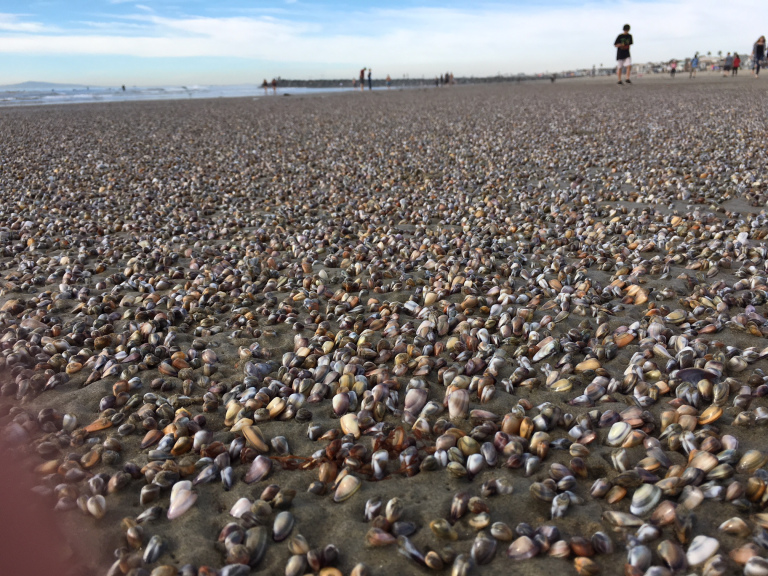
Clams Everywhere

by Carrie Wilson
1-25-2018
Website
Question: What causes thousands and thousands of tiny clams to be left on shore at Newport Beach as far as the eye can see? This was Sunday, Jan. 14. Does this happen regularly, and if so, why? (Edwin Marcus)
Answer: Those appear to be bean clams (Donax gouldii). This is a Southern California clam species found on sandy shores from Point Conception to southern Baja. Bean clams are known for their large, observable population fluctuations. In fact, population surveys conducted by a researcher at Scripps Coastal Reserve from 1949 to 1952 showed densities peaking at 20,000 clams per square meter, while in years preceding and following this boon, densities fell below one clam per square meter. These population resurgences were found to occur every two to 14 years. Female bean clams reach sexual maturity after their first year and sometimes spawn more than once a year. They are broadcast spawners, producing up to 50,000 eggs each spawning event. They can reach a maximum length of one-and-a-half inches, and they can live up to three years.
Bean clams bury themselves in the sand, but when extreme low tide conditions combine with wind and swell, they can become exposed. The good news is that as long as the shells remain closed, they will likely survive and get pushed out to sea when the tide returns.
The time stamp on your photo shows that it was taken around 2 p.m. on Jan. 14. There was a low, minus tide at Newport Beach at that time, which would explain why so many were left exposed in the intertidal zone where they reside.
Pintail Possession
Question: When I was hunting ducks at Gray Lodge Wildlife Area last weekend, a guy who was hunting nearby shot a pintail and it came down right in my decoys. My dog Charlie, doing what labs do, was on it in an instant and within seconds delivered it back to me. I quickly euthanized it. I looked up and the hunter was coming my way. I gave him the bird and he was thankful. I am just curious, what does the law require in that scenario? (Michael)
Answer: You did the right thing, legally and ethically. Fish and Game Code (FGC), section 2011 sums it up succinctly. It is unlawful for any person to take, mutilate or destroy any bird or mammal lawfully in the possession of another. Section 2011 further states a bird or mammal shall be deemed in possession when he or she physically possesses it or when it is wounded or otherwise maimed and the person who wounded or otherwise maimed it is in hot pursuit. The other hunter clearly shot the bird and was in hot pursuit. You did the right thing by quickly euthanizing it, then giving it to your fellow Gray Lodge hunter. You can tell Charlie he’s a good boy!
Leave the Honking to the Geese
Question: On the last weekend of duck season last year, right in broad daylight, I watched some guys at the duck club next to ours drive their pickup on the outer perimeter road, which is right next to our club, blaring their horn in an effort to get a group of ducks and geese off a pond to fly over where their friends were hunting. This can’t be legal and seems to violate fair chase principles. Is there actually a law that prohibits it? Is there anything I can do about it? (Jeremy)
Answer: You are correct – this behavior is not legal. FGC, section 3501 very clearly states that it is unlawful to use any powerboat, motor vehicle or airplane to drive any game bird toward another person with the intent that the other person shall take the bird.
There are a few things you can do. If you see this behavior again, get the license plate number of the vehicle and, if you can, a description of the driver. If you are able to take photos or shoot video with your cell phone, even better. Gather as much information as possible and call CalTIP (1-888-334-2258). The number is on the back of every hunting and fishing license so you’ll always have it with you.
Carrie Wilson is a marine environmental scientist with the California Department of Fish and Wildlife. While she cannot personally answer everyone’s questions, she will select a few to answer each week in this column. Please contact her at CalOutdoors@wildlife.ca.gov.
Website Hosting and Design provided by TECK.net